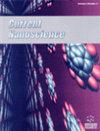二氢槲皮素纳米乳液的稳定性和体外抗癌活性评估
IF 1.5
4区 材料科学
Q4 BIOTECHNOLOGY & APPLIED MICROBIOLOGY
引用次数: 0
摘要
背景:二氢槲皮素(DHQ)又称紫杉叶素,是一种常见于多种植物中的类黄酮。据记载,二氢槲皮素具有强大的抗氧化活性和许多有益于人体健康的特性,特别是它能够抑制某些类型的癌细胞。然而,它的低溶解度和生物利用率是生物医学应用的主要障碍。此外,DHQ 的化学性质不稳定,在碱性条件下会迅速降解:二氢槲皮素(DHQ)又称紫杉叶素,是一种黄酮类化合物,常见于许多植物中。据记载,二氢槲皮素具有强大的抗氧化活性和许多有益于人体健康的特性,特别是它能够抑制某些类型的癌细胞。然而,它的低溶解度和生物利用率是生物医学应用的主要障碍。此外,DHQ 的化学性质不稳定,在碱性条件下会迅速降解。研究目的本研究采用自纳米乳化给药系统(SNEDDS)技术制备了一种 DHQ 纳米乳剂配方,以克服上述缺点。制备方法采用四氮唑染料(MTS 试验)对所制备的纳米乳液系统的微观特性、稳定性以及对某些癌细胞的体外细胞毒性活性进行了评估。结果显示测量结果表明,DHQ 纳米乳液已成功合成,典型的平均液滴尺寸为 9 至 11 纳米,并显示出卓越的长期稳定性。纳米乳液形式的二氢槲皮素比非包囊形式的二氢槲皮素更稳定,这体现在分散在水溶液中长达 48 小时后,液滴大小仍保持在纳米范围内。这种稳定性在酸性和中性环境中都尤为明显。针对 A549、Hela 和 HepG2 癌细胞株的细胞毒性体外实验表明,制备的 DHQ 纳米乳液能有效抑制所有这些细胞株的生长,其 IC50 值(μg/mL)分别为 8.0、20.4 和 29.5。结论从上述详细结果可以看出,DHQ 的溶解度和生物利用度可以通过纳米乳剂形式的纳米结构得到改善。此外,与游离的 DHQ 相比,稳定的纳米乳液中的纳米形式 DHQ 在抑制癌细胞方面表现出更好的性能。因此,利用纳米 DHQ 乳剂开发癌症疗法还需要进一步研究。本文章由计算机程序翻译,如有差异,请以英文原文为准。
Evaluation of Stability and In vitro Anti-Cancer Activity of Dihydroquercetin Nanoemulsion
Background: Dihydroquercetin (DHQ), also known as taxifolin, is a flavonoid commonly found in many plants. Dihydroquercetin has been documented to have powerful antioxidant activity and many beneficial properties for human health, especially its ability to inhibit certain types of cancer cells. However, its low solubility and bioavailability are major obstacles to biomedical applications. Moreover, DHQ is chemically unstable and quickly degrades when exposed to alkaline conditions. background: Dihydroquercetin (DHQ), also known as taxifolin, is a flavonoid and commonly found in many plants. Dihydroquercetin has been documented to have powerful antioxidant activity and many beneficial properties for human health, especially its ability to inhibit certain types of cancer cells. However, its low solubility and bioavailability are major obstacles to biomedical applications. Moreover, DHQ is chemically unstable and quickly degrades when exposed to alkaline conditions. Objective: In the present study, a DHQ nanoemulsion formulation was prepared by Self Nano- Emulsifying Drug Delivery System (SNEDDS) technique to overcome the above disadvantages. Methods: The obtained nanoemulsion system was evaluated for its micro-properties, stability, and in vitro cytotoxic activity against some cancer cells using tetrazolium dyes (MTS assay). Results: Measurement results showed that the DHQ nanoemulsion was successfully synthesized with typical mean droplet sizes from 9 to 11 nm, and revealed excellent stability over time. Dihydroquercetin in nanoemulsion form is more stable than the non-encapsulated form, as evidenced by the maintenance of droplet size in the nanometer range when dispersed in aqueous solution for up to 48 hours. This stability is particularly pronounced in both acidic and neutral environments. In vitro experiments on cytotoxic activities against A549, Hela, and HepG2 cancer cell lines indicated that the prepared DHQ nanoemulsion effectively inhibited the growth of all these cell lines with IC50 values (μg/mL) of 8.0, 20.4, and 29.5 respectively. Conclusion: From the detailed results above, it is evident that the solubility and bioavailability of DHQ can be improved by creating its nanostructure in the form of nanoemulsions. Furthermore, the nano form of DHQ carried within stable nanoemulsions exhibited better performance in inhibiting cancer cells compared to free DHQ. Therefore, further research is required to explore the development of cancer therapeutics utilizing nano DHQ emulsions.
求助全文
通过发布文献求助,成功后即可免费获取论文全文。
去求助
来源期刊

Current Nanoscience
工程技术-材料科学:综合
CiteScore
3.50
自引率
6.70%
发文量
83
审稿时长
4.4 months
期刊介绍:
Current Nanoscience publishes (a) Authoritative/Mini Reviews, and (b) Original Research and Highlights written by experts covering the most recent advances in nanoscience and nanotechnology. All aspects of the field are represented including nano-structures, nano-bubbles, nano-droplets and nanofluids. Applications of nanoscience in physics, material science, chemistry, synthesis, environmental science, electronics, biomedical nanotechnology, biomedical engineering, biotechnology, medicine and pharmaceuticals are also covered. The journal is essential to all researches involved in nanoscience and its applied and fundamental areas of science, chemistry, physics, material science, engineering and medicine.
Current Nanoscience also welcomes submissions on the following topics of Nanoscience and Nanotechnology:
Nanoelectronics and photonics
Advanced Nanomaterials
Nanofabrication and measurement
Nanobiotechnology and nanomedicine
Nanotechnology for energy
Sensors and actuator
Computational nanoscience and technology.
 求助内容:
求助内容: 应助结果提醒方式:
应助结果提醒方式:


